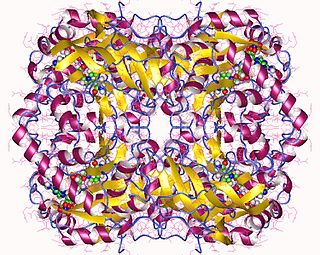| Sulfoacetaldehyde reductase | |||||||||
|---|---|---|---|---|---|---|---|---|---|
| Identifiers | |||||||||
| EC no. | 1.1.1.313 | ||||||||
| Databases | |||||||||
| IntEnz | IntEnz view | ||||||||
| BRENDA | BRENDA entry | ||||||||
| ExPASy | NiceZyme view | ||||||||
| KEGG | KEGG entry | ||||||||
| MetaCyc | metabolic pathway | ||||||||
| PRIAM | profile | ||||||||
| PDB structures | RCSB PDB PDBe PDBsum | ||||||||
| |||||||||
Sulfoacetaldehyde reductase (EC 1.1.1.313, ISFD) is an enzyme with systematic name isethionate:NADP+ oxidoreductase. [1] This enzyme catalyses the following chemical reaction
- isethionate + NADP+ 2-sulfoacetaldehyde + NADPH + H+
This enzyme catalyses the reaction in the reverse direction.



